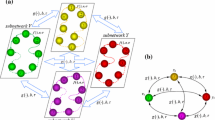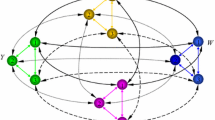Abstract
It is well known that brain neural networks are composed of hundreds of millions of neurons with complicated connections. It is noteworthy that there are a large number of neural circuits formed by the coupling relationship in neural networks. However, the vast majority of existing studies on ring-structured networks were restricted to models with fewer neurons or single-ring structure. Here, we design a multi-ring coupling network model, which includes a large number of neurons and multiple rings, to simulate the brain network with multiple neural circuits, and use bifurcation theory to investigate the dynamic behavior of bifurcations and oscillations of the proposed model. Instead of the traditional method, the Coates flow graph method is used to derive explicit expressions for the higher-order determinants of the model. Then, the stability and Hopf bifurcation of the model are studied with the sum of discrete delays of each ring as the bifurcation parameter, and the explicit formula for its critical value is deduced. Our results suggest that in some cases, the stability of the model gradually deteriorates with increasing time delay and eventually destabilizes the system at some critical value. More specifically, the development of the instability (increasing time delay) leads to limit cycle and periodic oscillations, and the amplitude and period of the system are also affected by it.








Similar content being viewed by others
References
Sarubbo S, Tate M, De Benedictis A, Merler S, Moritz-Gasser S, Herbet G, et al. Mapping critical cortical hubs and white matter pathways by direct electrical stimulation: an original functional atlas of the human brain. Neuroimage. 2020;205.
Dong P, Wang H, Shen X, Jiang P, Zhu X, Li Y, et al. A novel cortico-intrathalamic circuit for flight behavior. Nat Neurosci. 2019;22:941–9.
Davis FP, Nern A, Picard S, Reiser MB, Rubin GM, Eddy SR, et al. A genetic, genomic, and computational resource for exploring neural circuit function. Elife. 2020;9.
Herry C, Johansen JP. Encoding of fear learning and memory in distributed neuronal circuits. Nat Neurosci. 2014;17:1644–54.
Tierney AJ. Evolutionary implications of neural circuit structure and function. Behav Processes. 1995;35:173–82.
Guo ZV, Inagaki HK, Daie K, Druckmann S, Gerfen CR, Svoboda K. Maintenance of persistent activity in a frontal thalamocortical loop. Nature. 2017;545:181–6.
Alon U. An introduction to systems biology: design principles of biological circuits. Boca Raton: CRC Press; 2006.
Huang C, Nie X, Zhao X, Song Q, Tu Z, Xiao M, et al. Novel bifurcation results for a delayed fractional-order quaternion-valued neural network. Neural Netw. 2019;117:67–93.
Hopfield JJ. Neurons with graded response have collective computational properties like those of two-state neurons. Proc Natl Acad Sci USA. 1984;81:3088–92.
Xu C, Zhang Q, Wu Y. Bifurcation Analysis of Two-Neuron Networks with Discrete and Distributed Delays. Cogn Comput. 2016;8:1103–8.
Xu C, Aouiti C. Comparative analysis on Hopf bifurcation of integer-order and fractional-order two-neuron neural networks with delay. Int J Circ Theor App. 2020;48:1459–75.
Ali MS, Narayanan G, Shekher V, Alsulami H, Saeed T. Dynamic stability analysis of stochastic fractional-order memristor fuzzy BAM neural networks with delay and leakage terms. Appl Math Comput. 2020;369.
Lin F, Zhang Z. Global Asymptotic Synchronization of a Class of BAM Neural Networks with Time Delays via Integrating Inequality Techniques. J Syst Sci Complex. 2020;33:366–82.
Xiao M, Zheng W, Cao J. Hopf bifurcation of an (n+1)-neuron BAM neural network model with delays. IEEE Trans Neural Netw Learn Syst. 2013;24:118–32.
Lin J, Xu R, Li L. Effect of leakage delay on Hopf bifurcation in a fractional BAM neural network. Int J Bifurcation Chaos. 2019;29:1950077.
Brewer GJ, Boehler MD, Leondopulos SS, Pan, L, Alagapan S, Demarse TB, et al. Toward a self-wired active reconstruction of the hippocampal trisynaptic loop: DG-CA3. Front Neural Circuits. 2013;7:165–165.
Stoodley CJ. The Cerebellum and Neurodevelopmental Disorders. Cerebellum. 2016;15:34–37.
Sui M, Wang Y, Han X, Kloeden PE. Random recurrent neural networks with delays. J Differ Equations. 2020;269:8597–8639.
Aouiti C, Mhamdi MS, Chérif F, Alimi AM. Impulsive generalized high-order recurrent neural networks with mixed delays: stability and periodicity. Neurocomputing. 2018;321:296–307.
Wei J, Li M. Global existence of periodic solutions in a tri-neuron network model with delays. Physica D. 2004;198:106–119.
Hu H, Huang L. Stability and Hopf bifurcation analysis on a ring of four neurons with delays. Appl Math Comput. 2009;213:587–599.
Cheng C. Coexistence of multistability and chaos in a ring of discrete neural network with delays. Int J Bifurcation Chaos. 2010;20:1119–1136.
Mao X, Wang Z. Stability, bifurcation, and synchronization of delay-coupled ring neural networks. Nonlinear Dyn. 2016;84:1063–1078.
Takiyama K. Influence of neural adaptation on dynamics and equilibrium state of neural activities in a ring neural network. J Phys A: Math Theor. 2017;50:495601.
Tyagi S, Abbas S, Kirane M. Global asymptotic and exponential synchronization of ring neural network with reaction diffusion term and unbounded delay. Neural Comput & Applic. 2018;30:487–501.
Cheng Z, Xie K, Wang T, Cao J. Stability and Hopf bifurcation of three-triangle neural networks with delays. Neurocomputing. 2018;322:206–215.
Mattia M, Biggio M, Galluzzi A, Storace M. Dimensional reduction in networks of nonMarkovian spiking neurons: Equivalence of synaptic filtering and heterogeneous propagation delays. PLoS Comput Biol. 2019;5:e1007404.
Katz B, Miledi R. The effect of temperature on the synaptic delay at the neuromuscular junction. J Physiol. 1965;181:656–670.
Lameu EL, Macau EEN, Borges FS, Iarosz KC, Caldas IL, Borges RR, et al. Alterations in brain connectivity due to plasticity and synaptic delay. Eur Phys J Spec Top. 2018;227:673–682.
Jirsa VK, McIntosh AR. Handbook of Brain Connectivity. New York: Springer; 2007.
Zhang H, Zheng Y, Su J, Xiao P. Seizures dynamics in a neural field model of cortical-thalamic circuitry. Sci China Tech Sci. 2017;60:974–984.
Desoer CA. The optimum formula for the gain of a flow graph or a simple derivation of Coates’ formula. Proc IRE. 1960;48:883–889.
Robinson SM. A short proof of Cramer’s rule. Math Mag. 1970;43:94–95.
Ruan S, Wei J. On the zeros of transcendental functions with applications to stability of delay differential equations with two delays. Dynam Cont Dis Ser A. 2003;10:863–874.
Acknowledgements
This work is supported in part by the National Natural Science Foundation of China (Grant Nos. 62073172, 61573194), the Natural Science Foundation of Jiangsu Province of China (Grant No. BK20181389), and the Postgraduate Research & Practice Innovation Program of Jiangsu Province (Grant Nos. SJCX19_0263, KYCX19_0976)
Author information
Authors and Affiliations
Corresponding author
Ethics declarations
Conflict of Interest
The authors declare that they have no conflict of interest.
Ethical Approval
This article does not contain any experiments with human or animal participants performed by any of the authors
Informed Consent
Informed consent was obtained from all individual participants included in the study.
Rights and permissions
About this article
Cite this article
Zhou, S., Xiao, M., Wang, L. et al. Bifurcation and Oscillations of a Multi-ring Coupling Neural Network with Discrete Delays. Cogn Comput 13, 1233–1245 (2021). https://doi.org/10.1007/s12559-021-09920-y
Received:
Accepted:
Published:
Issue Date:
DOI: https://doi.org/10.1007/s12559-021-09920-y




